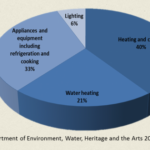Beginners Guides
How Many Kwh Are Necessary For Tiny House?
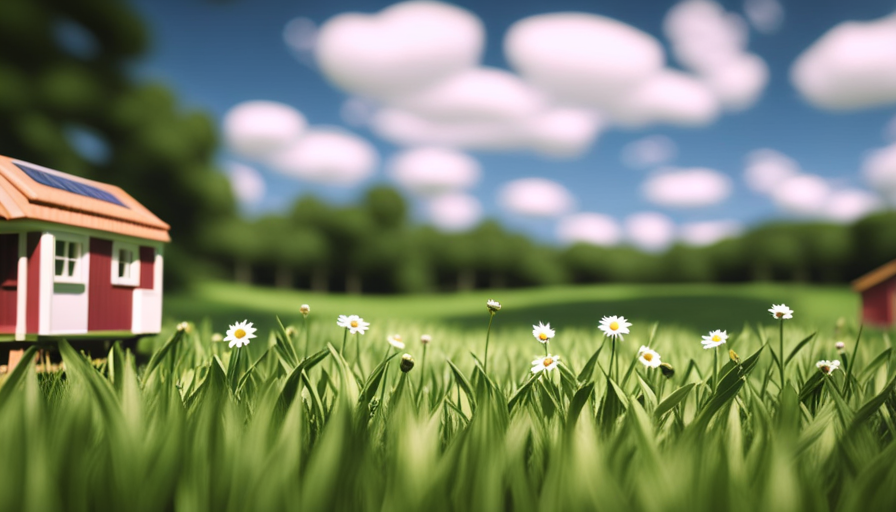
Have you ever been curious about the amount of energy a small house really uses? Prepare to be amazed! It appears that these compact homes consume considerably less kilowatt-hours (kWh) compared to bigger homes.
In fact, the energy consumption of a tiny house can be so low that it’s almost laughable.
In this article, I will delve into the fascinating world of energy consumption in tiny houses. We’ll explore the factors that affect power needs, calculate average usage, and discuss choosing energy-efficient appliances and systems.
But that’s not all – I’ll also share some handy tips for reducing energy consumption in these compact abodes.
Whether you’re considering downsizing to a tiny house or simply curious about their sustainability benefits, this article has got you covered. So buckle up and prepare to be amazed by just how little electricity a tiny house really requires!
Key Takeaways
- Tiny houses require fewer kWh than larger houses.
- Factors affecting power needs in tiny houses include insulation, energy-efficient appliances, and passive solar design.
- Renewable energy sources like solar panels and wind turbines can provide sustainable power for tiny houses.
- Evaluating power needs for tiny house living involves considering energy-efficient appliances, lifestyle and usage patterns, and climate and location.
Understanding Energy Consumption in Tiny Houses
You’ll be amazed at how little energy your tiny house consumes! Understanding energy efficient design and optimizing power usage are key factors in minimizing energy consumption in a tiny house.
With limited space, it’s important to make the most of every square inch when it comes to energy efficiency. One way to achieve this is by using insulation materials that provide a high level of thermal resistance. This helps keep the interior temperature stable, reducing the need for heating or cooling systems.
Additionally, installing energy-efficient appliances such as LED lights and low-flow water fixtures can significantly decrease power usage. Another aspect to consider is passive solar design. By strategically placing windows and using natural shading techniques, you can harness the sun’s energy for heating and lighting purposes, further reducing your reliance on traditional power sources.
When evaluating power needs for tiny house living, it’s essential to assess your daily activities and prioritize your electricity usage accordingly. Investing in renewable energy sources like solar panels or wind turbines can provide an independent and sustainable power supply for your tiny house.
By understanding energy efficient design principles and optimizing power usage, you can greatly reduce your overall energy consumption in a tiny house. Now let’s move on to evaluating power needs for tiny house living without compromising comfort or convenience.
Evaluating Power Needs for Tiny House Living
Calculating the power requirements for a cozy abode on a smaller scale is like unraveling a delightful puzzle. It’s essential to evaluate power needs accurately to ensure that your tiny house has enough electricity to run smoothly.
To help you navigate this process, here are three key factors to consider:
-
Energy Efficient Appliances: Opting for energy-efficient appliances can significantly reduce your power needs. Look for appliances with an ENERGY STAR rating or those specifically designed for off-grid living.
-
Lifestyle and Usage Patterns: Consider your daily routines and habits when evaluating power needs. Do you work from home? Do you enjoy cooking elaborate meals? Understanding how you use electricity will help determine the appropriate capacity.
-
Climate and Location: Different climates require varying amounts of energy for heating or cooling purposes. Take into account the local weather conditions and insulation levels of your tiny house.
By evaluating these aspects, you can assess how many kilowatt-hours (kWh) are necessary for your tiny house lifestyle.
The next step in understanding energy consumption in tiny homes is calculating average energy usage based on these requirements without unnecessary waste or overspending on resources.
Calculating Average Energy Usage in Tiny Homes
When it comes to determining how much energy your cozy abode needs, it’s important to consider your lifestyle and daily habits. Calculating energy efficiency and optimizing power usage are key factors in ensuring you have the right amount of electricity for your tiny house. To help you understand average energy usage in tiny homes, let’s take a look at the following table:
| Appliance | Power Consumption (kWh) |
|---|---|
| Refrigerator | 1-2 kWh/day |
| Lights | 0.5-1 kWh/day |
| Heating/Cooling | 2-3 kWh/day |
| Electronics | Varies |
By analyzing these numbers, you can estimate an average daily energy consumption for your tiny house. However, keep in mind that individual lifestyles may vary and additional appliances or gadgets will increase usage.
Understanding how much energy is necessary for a tiny home is crucial in order to optimize power usage and avoid wastage. Factors affecting energy consumption in compact dwellings will be discussed further in the next section, where we’ll delve into things like insulation, solar panels, and efficient appliances.
Factors Affecting Energy Consumption in Compact Dwellings
Optimizing power usage in compact dwellings is crucial for reducing energy consumption and maximizing efficiency. When evaluating energy-efficient options, it’s important to consider the factors that can affect energy consumption in tiny homes.
One key factor is insulation. Proper insulation helps maintain a comfortable temperature inside the house, reducing the need for heating or cooling systems and therefore lowering energy usage.
Another factor to consider is lighting. Choosing LED bulbs instead of traditional incandescent ones can significantly reduce electricity consumption without compromising on brightness.
Additionally, appliance selection plays a vital role in optimizing energy usage. Energy Star certified appliances are designed to be more efficient, using less electricity while still providing the same level of performance.
It’s also worth noting that utilizing natural light through strategically placed windows and skylights can minimize the need for artificial lighting during daylight hours.
By evaluating these energy-efficient options and optimizing our energy usage, we can make significant strides towards reducing our environmental impact and saving on utility costs.
When it comes to choosing energy-efficient appliances and systems, there are several factors to consider… [transition into subsequent section]
Choosing Energy-Efficient Appliances and Systems
Selecting energy-efficient appliances and systems is a smart move to reduce energy consumption and save on utility bills. When it comes to tiny houses, where space is limited, choosing the right appliances becomes even more crucial. By opting for energy-saving options, you can ensure that your tiny house remains comfortable while minimizing its overall energy usage.
One effective way to select efficient appliances is by comparing their Energy Star ratings. These ratings indicate how much energy an appliance uses compared to similar models. Additionally, consider the size of the appliance and its capacity in relation to your needs. For example, a smaller refrigerator will consume less electricity than a larger one.
To further maximize efficiency, it’s important to invest in systems that work well together. For instance, pairing a high-efficiency HVAC system with proper insulation will help regulate temperature effectively while using minimal energy.
Here’s a table showcasing some key considerations when selecting energy-efficient appliances for your tiny house:
| Appliance | Energy Saving Tip |
|---|---|
| Refrigerator | Opt for an Energy Star certified model with appropriate size for your needs |
| HVAC System | Choose a high-efficiency unit that matches the square footage of your tiny house |
| Lighting | Use LED bulbs instead of traditional incandescent ones |
By implementing these energy-saving tips and selecting efficient appliances and systems, you can significantly reduce your tiny house’s overall energy consumption. In the next section, we’ll explore alternative energy sources for tiny houses without compromising on comfort or convenience.
Exploring Alternative Energy Sources for Tiny Houses
One way to power your compact home efficiently and sustainably is by exploring alternative energy sources. When it comes to small spaces, there are several renewable energy options available that can meet the energy needs of a tiny house.
Solar power is one popular choice for tiny homes, as it’s a clean and abundant source of energy. Installing solar panels on the roof of your tiny house can generate electricity from sunlight, which can be stored in batteries for later use.
Another alternative energy source for small spaces is wind power. While not as common as solar power for tiny houses, wind turbines can be used to harness the power of the wind and convert it into electricity. However, it’s important to note that wind turbines require a certain amount of space and may not be suitable for all locations.
In addition to solar and wind power, some tiny homeowners also explore hydroelectricity as an alternative energy source. If you have access to a nearby stream or river with a significant flow, installing a micro-hydro system can provide you with a reliable source of renewable energy.
Exploring alternative energy sources for your tiny house allows you to reduce your reliance on traditional grid-based electricity while living sustainably. By incorporating these renewable options into your compact living space, you can enjoy the benefits of clean and efficient energy generation without compromising on comfort or convenience.
Transition: Now that we’ve explored alternative energy sources for powering your tiny house efficiently, let’s move on to some tips for reducing overall energy consumption in small homes.
Tips for Reducing Energy Consumption in Tiny Homes
Now that we’ve explored alternative energy sources for tiny houses, let’s delve into some practical tips for reducing energy consumption in these small spaces. Energy saving is crucial when it comes to tiny homes, as every kilowatt-hour (kWh) counts.
Here are some effective strategies to help you minimize your energy usage and live more sustainably.
Firstly, optimize insulation by using high-quality materials and sealing any gaps or cracks. This will reduce the need for heating or cooling appliances, consequently lowering your energy consumption.
Secondly, invest in energy-efficient appliances such as LED lights, low-flow showerheads, and programmable thermostats. These upgrades can significantly decrease your overall power usage.
Additionally, utilize natural light as much as possible by incorporating large windows or skylights into your design. This will not only brighten up your space but also reduce reliance on artificial lighting during the day.
Furthermore, make sure to unplug electronics when they’re not in use and consider using power strips with switches to easily turn off multiple devices at once.
By implementing these energy-saving tips for tiny homes, you can greatly reduce your environmental impact while also cutting down on utility costs.
Transitioning into the subsequent section about managing energy usage in off-grid tiny house living, it’s important to understand how to effectively harness renewable energy sources for sustained power supply without relying on traditional grid systems.
Managing Energy Usage in Off-Grid Tiny House Living
To effectively manage your energy usage in an off-grid tiny home, envision a sustainable lifestyle that relies on renewable energy sources and minimizes reliance on traditional power grids.
Here are three key strategies for managing energy usage in your off-grid tiny house:
-
Install Energy Efficient Appliances: Choose appliances that are specifically designed to be energy efficient. Look for ENERGY STAR certified products that consume less electricity while still providing the functionality you need. This includes refrigerators, stoves, water heaters, and lighting fixtures.
-
Use Natural Lighting: Maximize the use of natural light during the day by strategically placing windows and skylights in your tiny home. This will reduce the need for artificial lighting and decrease overall energy consumption.
-
Implement Smart Power Management Systems: Invest in smart power management systems that monitor and control your energy usage. These systems can automatically turn off appliances when not in use or adjust power settings to optimize efficiency.
By managing your energy usage through these techniques, you can significantly reduce your reliance on external power sources and create a more sustainable living environment in your off-grid tiny house.
Transitioning into budgeting for electricity costs in a tiny house involves understanding how much electricity is needed to sustain your desired lifestyle while also considering the costs associated with generating that electricity without traditional grid connections.
Budgeting for Electricity Costs in a Tiny House
Implementing an effective budget for electricity costs in a small, off-grid dwelling necessitates careful consideration of energy consumption and the associated expenses. Budgeting for electricity costs in a tiny house requires understanding how much electricity is needed and finding ways to reduce usage to stay within budget. To assist with this process, I have created a table below that outlines common appliances found in a tiny house, their average power consumption (in watts), the estimated daily usage (in hours), and the total daily energy consumption (in watt-hours).
| Appliance | Power Consumption (W) | Daily Usage (hours) | Total Energy Consumption (Wh) |
|---|---|---|---|
| LED Lights | 5-10 | 6 | 30-60 |
| Laptop | 40-150 | 4 | 160-600 |
| Refrigerator | 50-200 | 24 | 1200-4800 |
| Water Pump | 100-300 | 1 | 100-300 |
By monitoring and limiting the usage of these appliances, it becomes easier to manage electricity costs. Additionally, investing in energy-efficient alternatives such as LED lights and low-power electronics can significantly reduce overall consumption. Transitioning into the next section about sustainability and environmental benefits of tiny house energy efficiency, it is important to note that reducing energy usage not only helps maintain a budget but also minimizes our ecological footprint.
Sustainability and Environmental Benefits of Tiny House Energy Efficiency
Transitioning into the next section, it’s remarkable how sustainable and environmentally friendly energy-efficient practices in tiny homes can be. One of the key factors contributing to this sustainability is the use of sustainable building materials. These materials aren’t just eco-friendly but also help in reducing energy consumption.
For instance, using insulation made from recycled or renewable materials can significantly reduce heating and cooling needs.
In addition to sustainable building materials, tiny houses often incorporate renewable energy options. Solar panels are a popular choice among tiny homeowners as they provide clean and unlimited power from the sun. These panels can generate enough electricity to meet the needs of a tiny house, making it self-sufficient and reducing reliance on traditional power sources.
By utilizing both sustainable building materials and renewable energy options, tiny houses have a lower carbon footprint compared to traditional homes. They minimize the consumption of non-renewable resources while maximizing energy efficiency. This not only benefits the environment but also helps homeowners save money on utility bills.
Overall, the sustainability and environmental benefits of energy-efficient practices in tiny homes are undeniable. Through the use of sustainable building materials and renewable energy options like solar panels, these small dwellings offer an efficient and eco-friendly living solution for those looking to minimize their impact on the planet while still enjoying a comfortable lifestyle.
Frequently Asked Questions
What is the average cost of electricity for a tiny house?
On average, the electricity cost for a tiny house is around $30 to $50 per month. However, there are several tips for saving energy in a tiny house.
Firstly, using energy-efficient appliances and LED lighting can significantly reduce consumption.
Secondly, insulating windows and doors properly helps maintain temperature.
Lastly, utilizing solar panels or wind turbines can generate renewable energy. By implementing these measures, you can minimize your electricity costs while enjoying sustainable living.
How can I reduce my energy consumption in a tiny house?
To reduce energy consumption in a tiny house, I recommend using energy-efficient appliances and considering solar power installation. Energy-efficient appliances are designed to use less electricity without compromising functionality. They can significantly decrease your overall energy usage.
Additionally, installing solar panels on your tiny house can harness renewable energy from the sun to power your home, reducing dependence on traditional electricity sources and lowering your utility bills.
What are some alternative energy sources that can be used in a tiny house?
When it comes to alternative energy sources for a tiny house, solar power and wind energy are two excellent options. Harnessing the power of the sun through solar panels can provide a reliable and sustainable source of electricity.
Additionally, utilizing wind turbines can generate energy from the natural breeze. By incorporating these renewable resources into a tiny house, one can significantly reduce their reliance on traditional energy sources and minimize their environmental impact.
How do I calculate the power needs for my specific tiny house?
To calculate the power needs for my specific tiny house, I need to consider several factors.
First, I’ll assess the energy efficient options available, such as solar panels, wind turbines, or propane generators.
Then, I’ll determine the energy consumption of each appliance and electrical device in my house.
By adding up these values and accounting for any potential future additions, I can accurately calculate my power needs for a self-sustainable tiny house.
Are there any incentives or government programs available for energy-efficient tiny houses?
Yes, there are government incentives and financial assistance programs available for energy-efficient tiny houses. These programs aim to encourage the adoption of eco-friendly practices by providing support in the form of grants, tax credits, and low-interest loans.
By taking advantage of these incentives, individuals can offset the initial costs associated with building or retrofitting a tiny house to be energy-efficient. This helps promote sustainability and reduces our overall environmental impact.
Conclusion
In conclusion, understanding and managing energy consumption in a tiny house is vital for sustainable living. By evaluating power needs, calculating average usage, and choosing energy-efficient appliances, we can minimize our environmental impact while enjoying the comforts of compact dwellings.
With careful budgeting and off-grid solutions, we can harness the power of renewable resources to meet our electricity needs. Embracing the benefits of tiny house energy efficiency not only saves us money but also allows us to tread lightly on Mother Earth’s delicate path.
Hi, I’m Emma. I’m the Editor in Chief of Tiny House 43, a blog all about tiny houses. While tree houses are often associated with childhood, they can be the perfect adult retreat. They offer a cozy space to relax and unwind, surrounded by nature. And since they’re typically built on stilts or raised platforms, they offer stunning views that traditional homes simply can’t match. If you’re looking for a unique and romantic getaway, a tree house tiny house might just be the perfect option.
Beginners Guides
How Do I Finance a Tiny House

I have always desired to own a small, comfortable home, but typical financing solutions appeared unattainable. That’s when I found out about the concept of tiny houses. These efficient, eco-friendly residences provide a budget-friendly option to conventional homes.
But how do I finance a tiny house? In this article, I’ll guide you through the various financing options and share practical tips for saving and budgeting. Whether you’re a minimalist enthusiast or simply looking to downsize, this article is here to help you make your tiny house dreams a reality.
Key Takeaways
- Financing options for tiny houses include personal loans, RV loans, and crowdfunding platforms.
- Traditional financing options such as bank loans and personal loans from banks or online lenders are available for tiny house financing.
- Alternative financing options like crowdfunding and personal loans can be explored, but they have their own pros and cons.
- Saving and budgeting for a tiny house is important, and options like obtaining a loan specifically designed for tiny house financing or exploring crowdfunding platforms can be considered.
Understanding the Cost of a Tiny House
I can’t believe how much it costs to build a tiny house. Understanding the financing process and the factors affecting the cost of a tiny house is crucial before embarking on this journey.
Firstly, let’s talk about the financing process. Many people choose to finance their tiny houses through personal loans, RV loans, or even crowdfunding platforms. It’s important to research and compare interest rates and terms to find the best option for your financial situation.
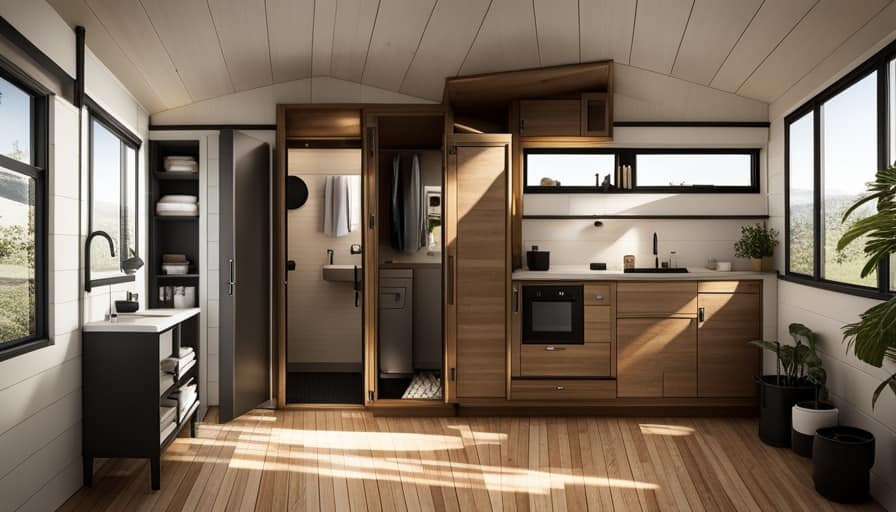
Now, let’s discuss the factors that affect the cost of a tiny house. Size, materials, and customization are the main factors. The larger the size, the more materials and labor will be required, thus increasing the cost. Additionally, using high-quality and sustainable materials can also raise the price. Lastly, customization, such as unique designs or added features, will add to the overall cost.
Exploring Traditional Financing Options
When exploring financing options for a tiny house, it’s important to consider traditional routes such as bank loans or credit unions. These options can provide the necessary funds to purchase or build your dream tiny house. Here are some key points to keep in mind when considering traditional financing options:
-
Traditional bank loans: Many banks offer loans specifically designed for home construction or purchases, which can be used for a tiny house.
-
Personal loans: If you don’t qualify for a traditional bank loan, personal loans from banks or online lenders can be a viable alternative.
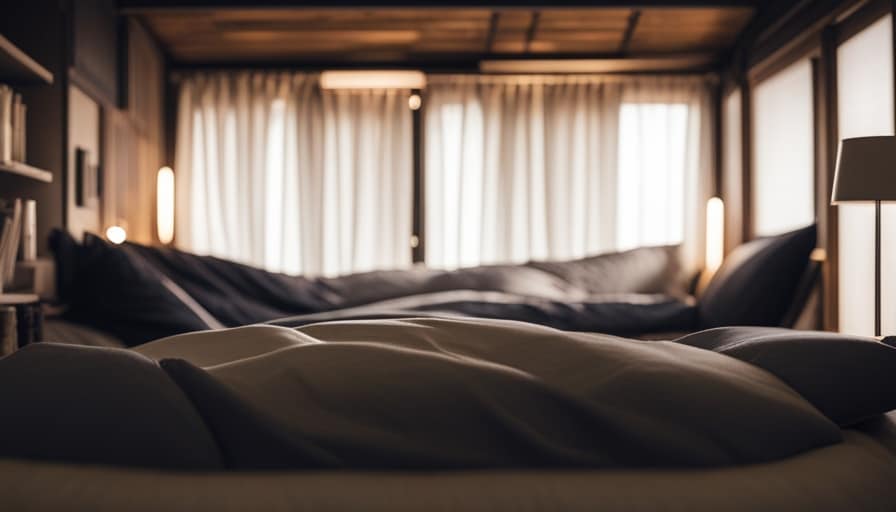
-
Interest rates: Traditional financing options may offer competitive interest rates, depending on your creditworthiness and other factors.
-
Repayment terms: It’s important to carefully review the repayment terms of any loan you consider, including the length of the loan and monthly payment amounts.
-
Eligibility requirements: Different lenders have different eligibility criteria, so it’s important to research and compare options to find the best fit for your needs.
Exploring traditional financing options can provide a solid foundation for financing your tiny house.

However, there are also alternative financing options worth considering, which will be explored in the next section.
Exploring Alternative Financing Options
One option to consider when exploring alternative financing options for a tiny house is crowdfunding. Crowdfunding is a method of raising funds by pooling small amounts of money from a large number of people. It can be a viable option for financing a tiny house as it allows individuals to contribute towards the project. Another alternative financing option is personal loans. Personal loans are loans that are not secured by any collateral, such as a house or car. They can be used to finance a variety of expenses, including the construction or purchase of a tiny house. When considering personal loans, it is important to shop around for the best interest rates and terms. Below is a table comparing crowdfunding and personal loans as alternative financing options for a tiny house:
| Financing Option | Pros | Cons |
|---|---|---|
| Crowdfunding | – Can raise funds from others | – No guarantee of reaching goal |
| Personal Loans | – Can be used for any purpose | – May require good credit score |
Both crowdfunding and personal loans can provide alternative financing options for a tiny house. It is important to carefully consider the pros and cons of each option before making a decision.
Tips for Saving and Budgeting for a Tiny House
Saving and budgeting for a tiny house involves prioritizing expenses and finding ways to cut costs. Here are some practical tips to help you save and budget effectively:
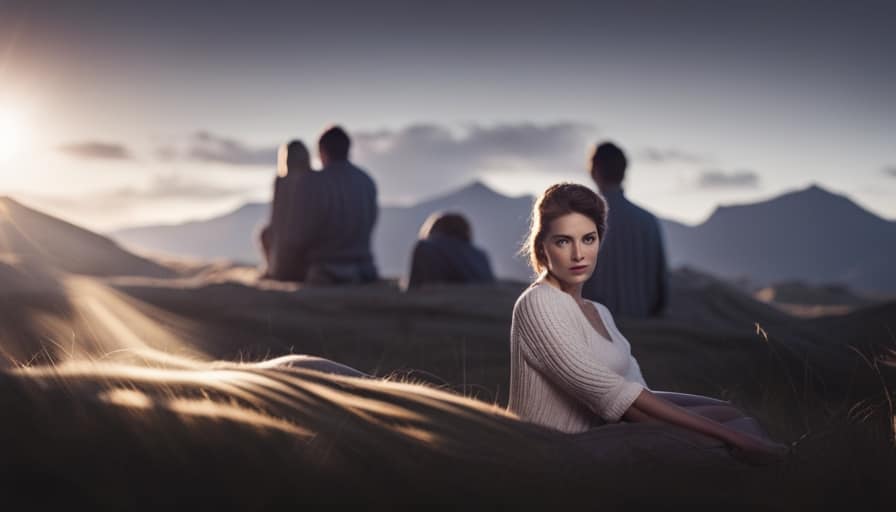
- Create a detailed budget: Start by listing all your expenses and income to determine how much you can allocate towards your tiny house.
- Cut unnecessary expenses: Identify areas where you can reduce spending, such as eating out less or canceling unused subscriptions.
- Save consistently: Set aside a certain amount of money each month specifically for your tiny house fund.
- Consider a tiny house loan: Research options for obtaining a loan specifically designed for tiny house financing.
- Explore crowdfunding options: Crowdfunding platforms can help you raise funds for your tiny house project by reaching out to a wider network of supporters.
By implementing these tips, you can make steady progress towards your goal of owning a tiny house.
Now, let’s explore some resources for grants and financial assistance to further support your journey.
Resources for Grants and Financial Assistance
I can explore various resources for grants and financial assistance to help me finance my tiny house. Grants are a great option to consider, as they provide funding that doesn’t need to be repaid.
There are several organizations and programs that offer grants specifically for individuals looking to build or purchase a tiny house. One such resource is the Tiny House Fund, which provides grants to low-income individuals and families for the construction of tiny houses.
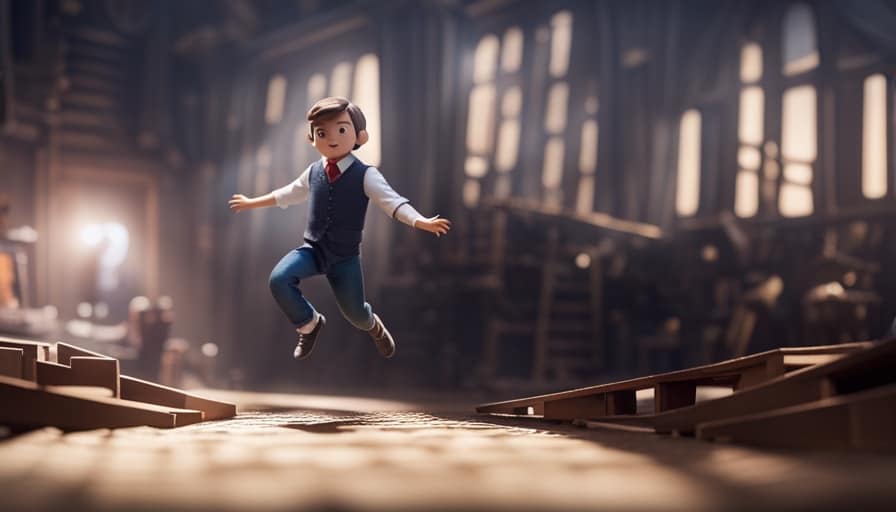
Another option is the Housing Assistance Council, which offers grants to organizations that provide housing assistance to low-income individuals.
It’s important to note that grants availability may vary depending on location and eligibility criteria. Therefore, it’s crucial to research and identify grants that align with your specific needs and circumstances.
Frequently Asked Questions
Can I Use a Personal Loan to Finance a Tiny House?
Yes, you can use a personal loan to finance a tiny house. It’s one of the alternative financing options available. However, make sure to research interest rates and terms to find the best option for you.
Are There Any Specific Qualifications I Need to Meet in Order to Obtain a Traditional Mortgage for a Tiny House?
To obtain a traditional mortgage for a tiny house, you need to meet certain qualifying criteria. The application process requires providing necessary documentation, such as income verification and credit history.

Are There Any Tax Benefits or Incentives Available for Financing a Tiny House?
Tax benefits and incentives can be available when financing a tiny house. It’s important to research and consult with a tax professional to understand the specific benefits that may apply to your situation.
What Are the Advantages and Disadvantages of Using Alternative Financing Options for a Tiny House?
Using alternative financing options for a tiny house has advantages, such as flexibility and lower interest rates, but also disadvantages, like stricter eligibility criteria. It’s important to weigh the pros and cons before deciding.
Are There Any Specific Tips or Strategies for Saving and Budgeting for a Tiny House That Differ From Traditional Homeownership?
When it comes to saving and budgeting for a tiny house, there are some specific tips and strategies that differ from traditional homeownership. Some budgeting strategies include cutting expenses, tracking spending, and setting realistic goals. Additionally, saving techniques like automating savings and finding ways to earn extra income can help you reach your financial goals faster.
Conclusion
In conclusion, financing a tiny house may seem daunting, but with careful planning and research, it can be achievable.
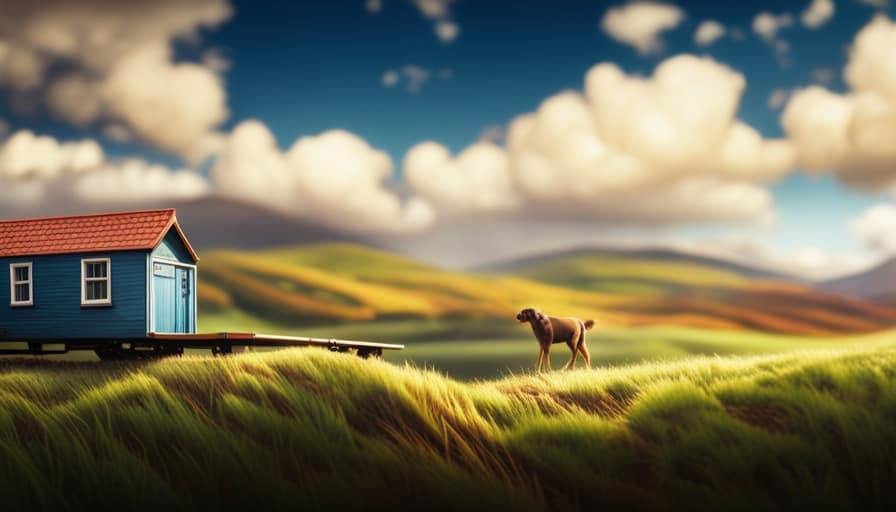
By understanding the costs involved, exploring traditional and alternative financing options, and implementing smart saving and budgeting strategies, you can make your dream of owning a tiny house a reality.
Remember, there are also resources available such as grants and financial assistance programs that can provide additional support.
So don’t let financial barriers hold you back, start exploring your options today and embark on your tiny house journey.
I’m Theodore, and I love tiny houses. In fact, I’m the author of Tiny House 43, a book about tiny houses that are also tree houses. I think they’re magical places where imaginations can run wild and adventures are just waiting to happen.
While tree houses are often associated with childhood, they can be the perfect adult retreat. They offer a cozy space to relax and unwind, surrounded by nature. And since they’re typically built on stilts or raised platforms, they offer stunning views that traditional homes simply can’t match.
If you’re looking for a unique and romantic getaway, a tree house tiny house might just be the perfect option.
Beginners Guides
How Do I Draw a Tiny House
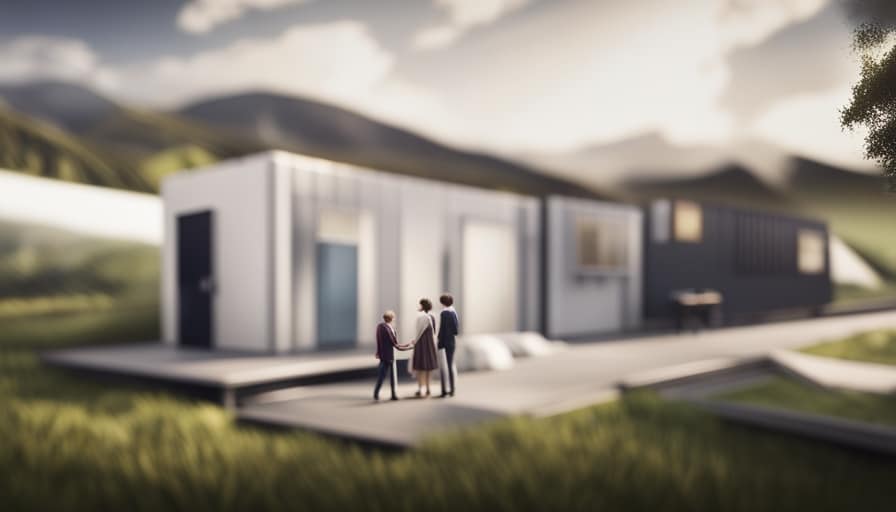
As a future architect, I am constantly captivated by the complexities involved in sketching a small house. It is often said that the beauty lies in the details, and this miniature masterpiece truly exemplifies that sentiment.
In this article, I will guide you through the process of creating a detailed and precise drawing of a tiny house. From understanding the basics of design to adding those finishing touches, you’ll discover how to bring your vision to life on paper.
Let’s dive in and unlock the secrets of drawing a tiny house!
Key Takeaways
- Tiny house design principles prioritize maximizing space in a small footprint and utilizing multi-functional spaces.
- Accurate measurements and choosing the appropriate scale are crucial for a precise and realistic representation.
- Sketching out the layout and floor plan should consider unique storage solutions, placement of windows for natural light, and attention to detail and proportions.
- Adding detail to tiny house elevations can be done by selecting the perfect color palette, incorporating unique architectural elements, and considering light, neutral tones or bold, vibrant colors.
Understanding the Basics of Tiny House Design
As I begin to draw a tiny house, I must first understand the basics of its design. Tiny house design principles are centered around maximizing space in a small footprint. When designing a tiny house, it’s crucial to carefully consider every inch of the layout.

One key principle is to prioritize multi-functional spaces. Each area should serve multiple purposes, such as a living room that can also convert into a bedroom. Storage is another important aspect, with clever solutions like built-in cabinets and hidden compartments. Additionally, utilizing vertical space through lofted areas or tall shelving can help maximize storage and living areas.
Choosing the Right Scale for Your Tiny House Drawing
I should consider the size and dimensions of my tiny house when choosing the right scale for my drawing. Accurate measurements are crucial in creating a precise and realistic representation of my tiny house. By using the correct scale, I can ensure that every element of the design is accurately depicted.
Exploring different design elements for my tiny house scale drawings allows me to experiment with various layouts and configurations. This not only helps me visualize the final result, but also enables me to make informed decisions regarding the placement of furniture, appliances, and other features.
Once I’ve determined the appropriate scale, I can confidently move on to sketching out the layout and floor plan, bringing my tiny house design to life.

Sketching Out the Layout and Floor Plan
Once I’ve chosen the right scale for my tiny house drawing, it’s important to start sketching out the layout and floor plan.
To ensure an efficient use of space, I’ll incorporate unique storage solutions. This can include built-in shelving, hidden compartments, and multi-functional furniture.
Additionally, I’ll carefully consider the placement of windows for optimal natural light. This won’t only enhance the overall ambiance of the tiny house but also reduce the need for artificial lighting during the day.
By strategically positioning windows in areas where sunlight is abundant, I can create a bright and airy atmosphere.

It’s crucial to prioritize both functionality and aesthetics when sketching out the layout and floor plan of a tiny house.
Adding Detail to Your Tiny House Elevations
While adding detail to my tiny house elevations, I’ll focus on incorporating architectural elements that enhance the overall design and character of the house.
One important aspect to consider is selecting the perfect color palette for your tiny house design. The colors you choose can greatly impact the visual appeal and atmosphere of your tiny home. Consider using light, neutral tones to create a spacious and airy feel, or bold and vibrant colors to add a pop of personality.
In addition to color, incorporating unique architectural elements into your tiny house elevation can make it stand out. Whether it’s a charming bay window, a decorative trim, or an interesting roofline, these elements can add visual interest and character to your tiny home.
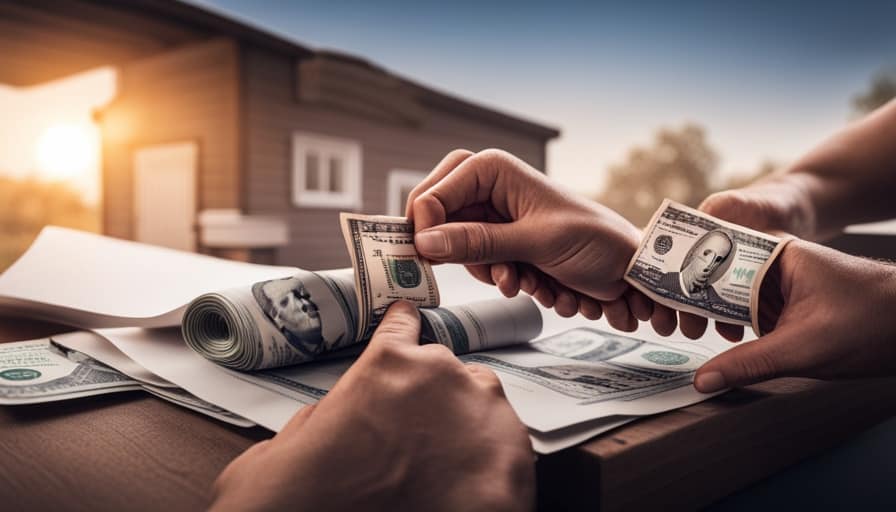
By carefully selecting colors and incorporating unique architectural elements, you can create a tiny house elevation that’s both visually appealing and reflective of your personal style.
Now, let’s move on to finalizing your tiny house drawing with finishing touches.
Finalizing Your Tiny House Drawing With Finishing Touches
Adding decorative details and selecting the right materials are key steps in finalizing your tiny house drawing with finishing touches. To ensure your tiny house design truly stands out, consider the following:
-
Selecting the perfect color palette: Choose colors that reflect your personal style and create an inviting atmosphere. Consider using light and neutral tones to make the space feel larger, or vibrant shades to add a pop of energy.
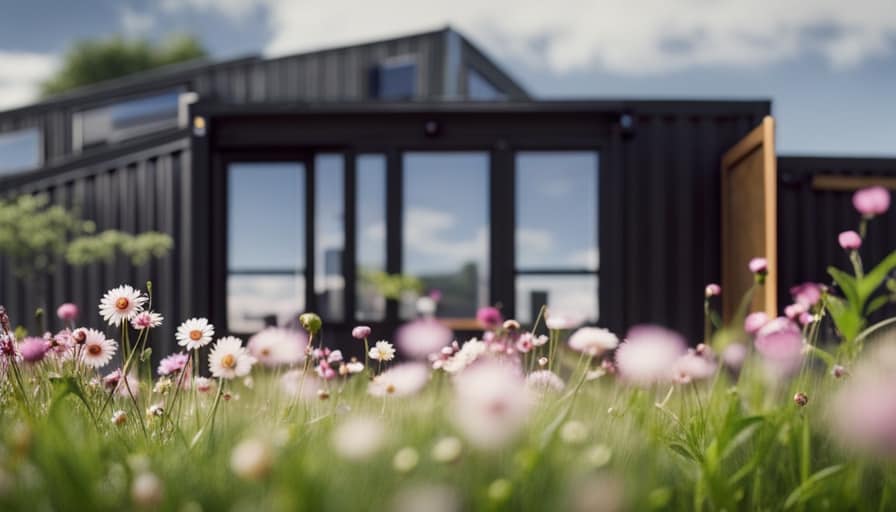
-
Incorporating sustainable and eco-friendly elements: Make your tiny house environmentally friendly by incorporating features such as solar panels, rainwater harvesting systems, and energy-efficient appliances. Use recycled or reclaimed materials whenever possible to reduce waste and minimize your environmental footprint.
-
Adding unique architectural details: Consider incorporating unique architectural elements like exposed beams, arched windows, or a charming front porch to give your tiny house character and charm.
-
Enhancing with landscaping: Don’t forget about the exterior! Enhance your tiny house design with landscaping elements such as flower beds, shrubs, or a small vegetable garden. This will add curb appeal and create a welcoming outdoor space.
Frequently Asked Questions
What Are Some Common Challenges or Obstacles to Consider When Designing a Tiny House?
When designing a tiny house, it is important to consider common challenges and obstacles such as space optimization and design challenges. These factors require precise planning and attention to detail to ensure optimal functionality and livability.
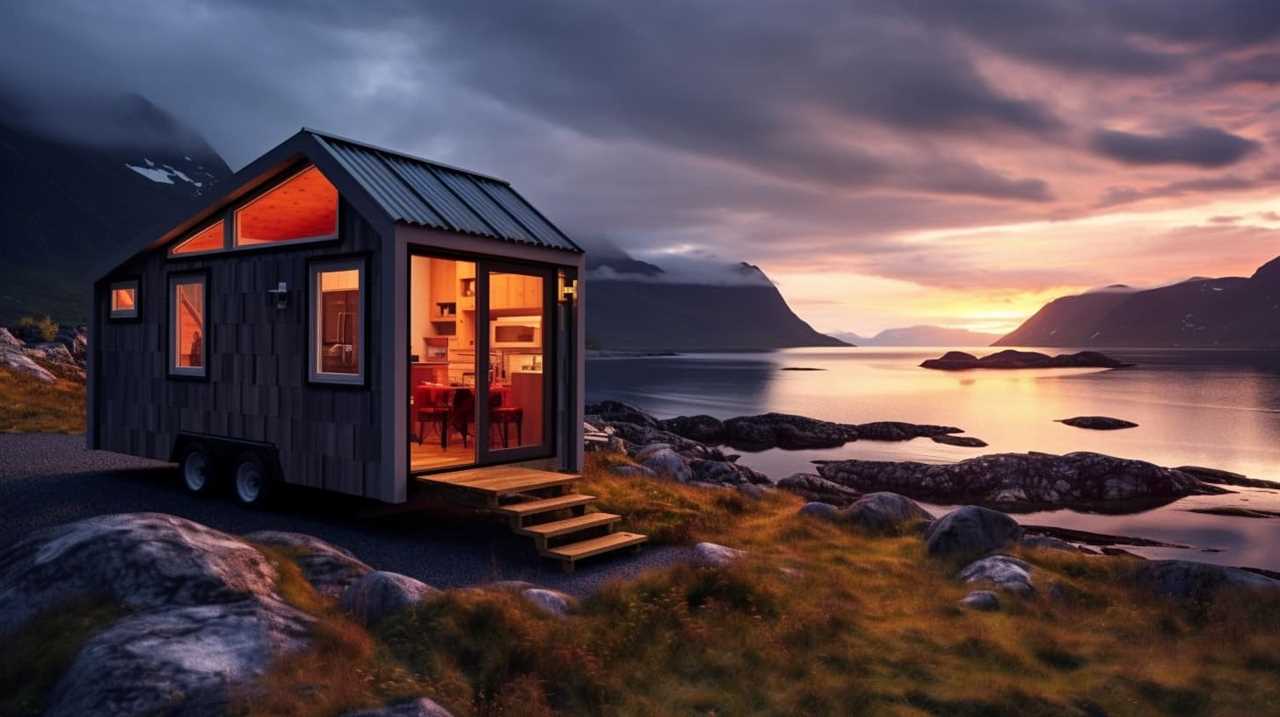
Can I Use Software or Online Tools to Create My Tiny House Drawing?
Yes, you can use software or online tools to create your tiny house drawing. It is best to follow these practices for creating detailed designs: utilize accurate measurements, incorporate necessary features, and ensure proper scaling for a realistic representation.
Are There Any Specific Building Codes or Regulations That I Should Be Aware of When Designing a Tiny House?
When designing a tiny house, it is important to be aware of building code requirements and zoning restrictions. These regulations ensure the safety and legality of your structure, so it’s crucial to familiarize yourself with them before starting your design process.
How Do I Incorporate Sustainable and Eco-Friendly Features Into My Tiny House Design?
To incorporate sustainable and eco-friendly features into my tiny house design, I can use eco-friendly materials like reclaimed wood and recycled insulation. Additionally, I can install energy-efficient systems such as solar panels and a rainwater harvesting system.
Are There Any Recommended Resources or Communities for Further Inspiration and Support in Designing a Tiny House?
There are recommended resources and communities for inspiration and support in tiny house design. Check out tiny house design competitions and online forums for enthusiasts. They provide valuable insights and connections for your project.
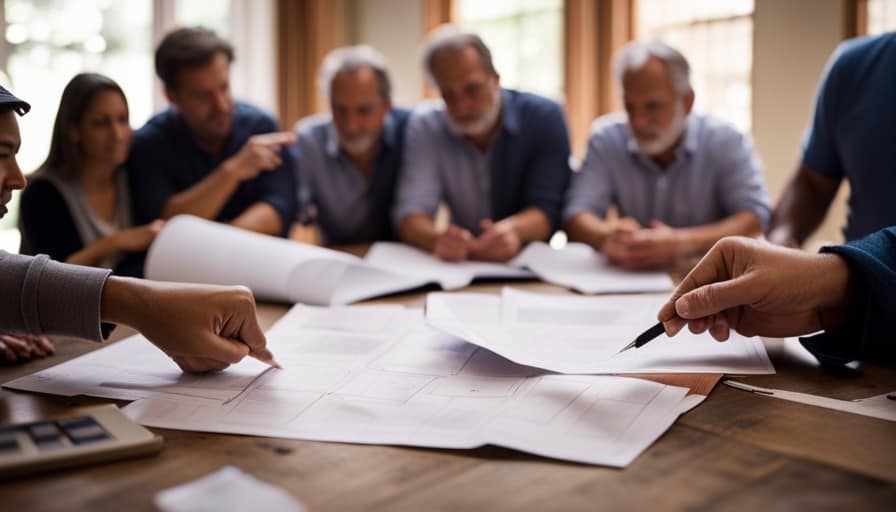
Conclusion
In conclusion, drawing a tiny house requires understanding the basics of design, choosing the right scale, and sketching out the layout and floor plan.
By adding detail to the elevations and finalizing the drawing with finishing touches, you can create a precise and detailed representation of your dream tiny home.
Just like a skilled architect carefully crafts a blueprint, your tiny house drawing will serve as the foundation for turning your vision into reality.
I’m Theodore, and I love tiny houses. In fact, I’m the author of Tiny House 43, a book about tiny houses that are also tree houses. I think they’re magical places where imaginations can run wild and adventures are just waiting to happen.
While tree houses are often associated with childhood, they can be the perfect adult retreat. They offer a cozy space to relax and unwind, surrounded by nature. And since they’re typically built on stilts or raised platforms, they offer stunning views that traditional homes simply can’t match.
If you’re looking for a unique and romantic getaway, a tree house tiny house might just be the perfect option.
Beginners Guides
How Do I Find a Tiny House for Sale for Adults

I’m always searching for the ideal tiny home. It feels like finding a needle in a haystack, but with the right approach, it can be done.
In this article, I’ll guide you through the process of finding a tiny house for sale that’s perfect for adults. From exploring online listings to connecting with builders and attending workshops, you’ll discover all the tips and tricks to make your dream of owning a tiny house a reality.
Let’s get started!
Key Takeaways
- The internet offers a wide range of options for finding tiny houses for sale, with online listings providing information on financing options and customization choices.
- Connecting with builders and companies can provide valuable information on purchasing and customizing a tiny house, as well as guidance on building regulations and permits.
- Utilizing social media and online communities can help tap into a network of like-minded individuals, gain recommendations, and access valuable insights and resources from the tiny house community.
- Attending workshops and events can provide education on financing options, networking opportunities, and exposure to the latest trends and designs in the tiny house community.
Exploring Online Listings and Websites
I can start my search for a tiny house by browsing through online listings and websites. The internet offers a vast array of options when it comes to finding a tiny house for sale. Not only can I explore different listings, but I can also learn more about the financing options available for tiny homes.

Many websites provide information on loans, grants, and other financial resources that can help make owning a tiny house a reality. Additionally, these online platforms showcase a variety of tiny house designs and customization options, allowing me to find a home that suits my preferences and needs.
Connecting With Tiny House Builders and Companies
By reaching out to tiny house builders and companies, I can explore my options and gather more information about the process of purchasing and customizing a tiny house. These professionals have extensive knowledge and expertise in building tiny houses and can guide me through the entire process.
When connecting with them, it’s important to inquire about building regulations to ensure that my tiny house meets all the necessary requirements. They can provide valuable insights and advice on navigating through the complexities of local zoning laws and permits.
Additionally, they can also offer information on financing options, such as loans or payment plans, to help make owning a tiny house more accessible.
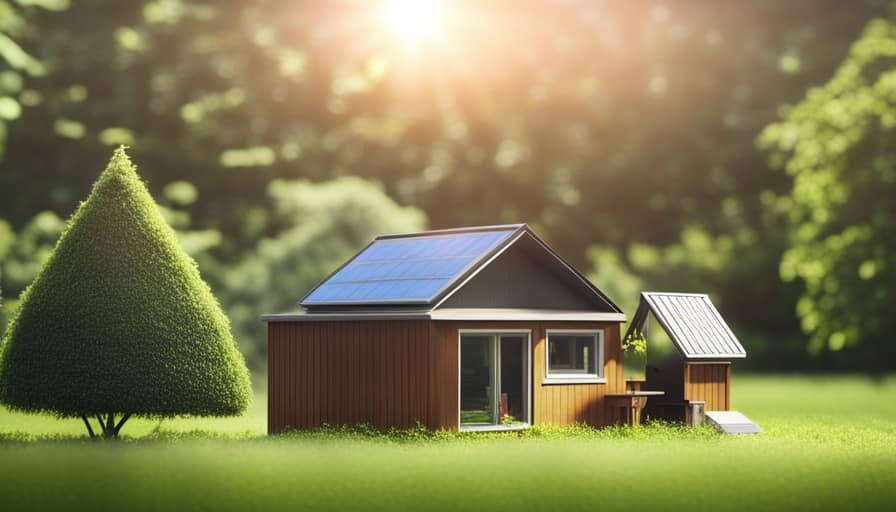
Utilizing Social Media and Online Communities
One can utilize social media and online communities to connect with fellow tiny house enthusiasts and discover potential listings for tiny houses for sale. Joining local groups on platforms like Facebook or Reddit can provide a wealth of information and resources. These groups often have members who are actively involved in the tiny house community and can offer valuable insights and recommendations. Engaging with these communities allows you to tap into a network of individuals who share your passion for tiny living and can guide you towards finding the perfect tiny house for sale.
Don’t hesitate to ask for recommendations within these groups, as members are usually more than willing to share their experiences and knowledge. By leveraging the power of social media and online communities, you can greatly increase your chances of finding the ideal tiny house for sale.
Now that we’ve explored the benefits of utilizing social media and online communities, let’s delve into the next step of the process – attending tiny house workshops and events.
Attending Tiny House Workshops and Events
To expand your knowledge and network in the world of tiny houses, consider attending workshops and events that focus on this unique lifestyle. These gatherings provide valuable opportunities to learn from experts, connect with like-minded individuals, and gain insight into the latest trends and innovations in the tiny house community. Here are three reasons why attending these workshops and events is beneficial:
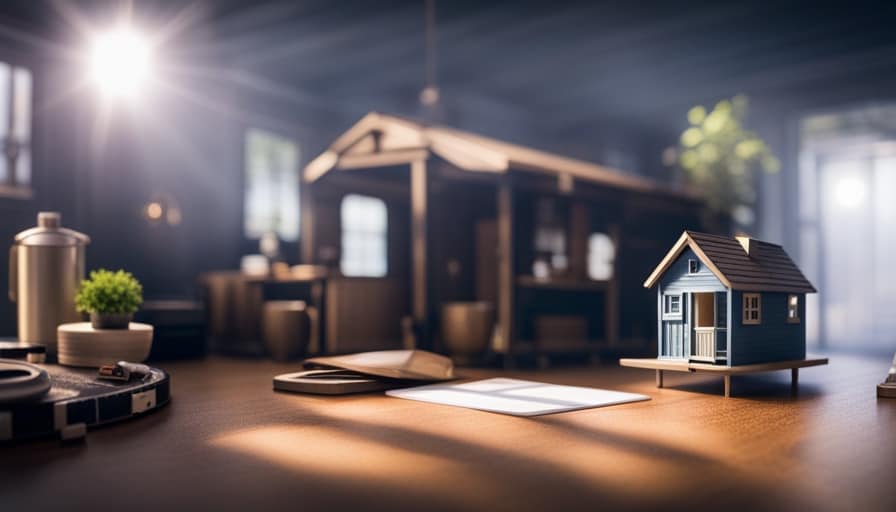
-
Education: Workshops and events offer a wealth of information on various topics, including tiny house financing options. You can learn about different financing methods, such as loans, grants, and crowdfunding, to help make your tiny house dream a reality.
-
Networking: Meeting fellow enthusiasts and professionals in the industry is a great way to expand your network. You can exchange ideas, share experiences, and potentially find partners or mentors who can guide you through the process of building a tiny house on a foundation.
-
Inspiration: By attending workshops and events, you’ll be exposed to a wide range of tiny house designs and styles. This exposure can inspire you to think creatively and find innovative solutions for your own tiny house project.
Considering Alternative Options for Tiny House Living
I’ve explored various tiny house options, but my favorite alternative is living in a converted shipping container. Not only are shipping containers affordable and readily available, but they also provide a unique and eco-friendly living space.

One of the best aspects of living in a converted shipping container is the opportunity to join tiny house communities. These communities are designed to foster a sense of connection and support among residents, creating a tight-knit community where everyone looks out for each other.
Additionally, renting options for converted shipping containers are becoming more popular, allowing individuals to experience the benefits of tiny house living without the commitment of purchasing a property. This flexibility is perfect for those who want to try out the lifestyle before fully committing.
Frequently Asked Questions
Are There Any Specific Regulations or Zoning Requirements for Placing a Tiny House on a Property?
Regulations and zoning requirements vary depending on the location. Before placing a tiny house on a property, it is important to research and comply with local laws. Consulting with a real estate professional can provide guidance in navigating these regulations.
What Are Some Common Challenges or Considerations When It Comes to Financing a Tiny House?
When it comes to financing a tiny house, there are several challenges to consider. Affordability is a major concern, as well as finding lenders who understand the unique nature of tiny homes.
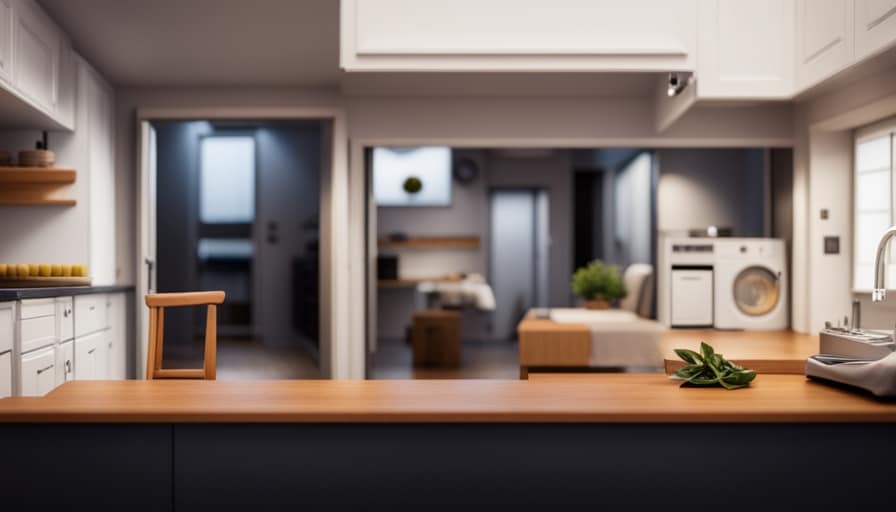
Can I Customize or Personalize a Pre-Built Tiny House From a Builder?
Yes, you can customize or personalize a pre-built tiny house from a builder. It allows you to tailor the design and features to your preferences, making it a unique and personalized space.
Are There Any Specific Insurance Considerations for Owning a Tiny House?
Insurance coverage for tiny houses requires considering their unique features and potential risks. It’s important to research insurance providers who specialize in tiny house coverage to ensure you have the right protection for your investment.
How Do I Navigate the Process of Finding Land or a Community to Park My Tiny House In?
Finding land or a community to park my tiny house in can be challenging. Research online platforms, local real estate agents, and tiny house communities. Visit potential locations, ask questions, and consider factors like zoning regulations and amenities.
Conclusion
In conclusion, there are several ways to make finding a tiny house for sale for adults easier. These include exploring online listings and websites, connecting with builders and companies, utilizing social media and online communities, and attending workshops and events.
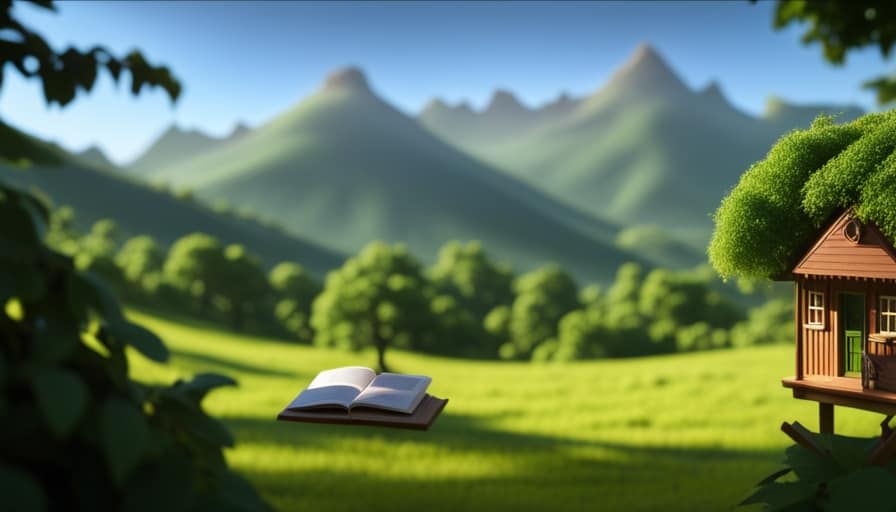
One effective method is to search for tiny houses for sale through online listings and websites. There are dedicated platforms that specialize in listing tiny houses, making it convenient to browse through various options and compare prices and features.
Another option is to connect directly with builders and companies that specialize in constructing and selling tiny houses. Many builders have websites where they showcase their designs and provide information on how to purchase or customize a tiny house according to specific needs and preferences.
Utilizing social media and online communities can also be helpful in finding a tiny house for sale. There are groups and pages dedicated to tiny house living where individuals can connect with others who are selling or buying tiny houses. These platforms provide a space for sharing information, asking questions, and even finding potential sellers or buyers.
Attending workshops and events related to tiny house living is another valuable way to find a tiny house for sale. These events often feature displays of different tiny house designs and provide an opportunity to meet builders, sellers, and other individuals who are passionate about tiny house living.

It’s interesting to note that the popularity of tiny house living is on the rise. According to a survey conducted by Tiny House Community, the number of adults opting for tiny house living has increased by 67% in the past five years. This statistic highlights the growing appeal and interest in this alternative lifestyle.
Overall, by utilizing online resources, connecting with builders and companies, engaging with social media and online communities, and attending workshops and events, adults can make the search for a tiny house for sale much easier.
I’m Theodore, and I love tiny houses. In fact, I’m the author of Tiny House 43, a book about tiny houses that are also tree houses. I think they’re magical places where imaginations can run wild and adventures are just waiting to happen.
While tree houses are often associated with childhood, they can be the perfect adult retreat. They offer a cozy space to relax and unwind, surrounded by nature. And since they’re typically built on stilts or raised platforms, they offer stunning views that traditional homes simply can’t match.
If you’re looking for a unique and romantic getaway, a tree house tiny house might just be the perfect option.
-

 Beginners Guides1 week ago
Beginners Guides1 week agoHow To Buy A Tesla Tiny House
-

 Energy Efficiency1 month ago
Energy Efficiency1 month agoBest Tiny Homes For Cold Climates
-

 Beginners Guides5 days ago
Beginners Guides5 days agoTiny House Nation Where Are They Now Stephanie
-

 Tiny House Resources (e.g., legalities, cost, insurance, FAQs)2 months ago
Tiny House Resources (e.g., legalities, cost, insurance, FAQs)2 months agoDo Tiny Homes Need Planning Permission?
-

 Beginners Guides2 weeks ago
Beginners Guides2 weeks agoFrom The Show Tiny House Nation How Many Keep Their Tiny House?
-

 Beginners Guides2 months ago
Beginners Guides2 months agoUsing a Climbing Net For Treehouse Construction
-

 Beginners Guides2 months ago
Beginners Guides2 months agoHow to Build a Treehouse Without Drilling Into the Tree
-

 Beginners Guides3 weeks ago
Beginners Guides3 weeks agoTiny House Nation Who Pays For The Houses




